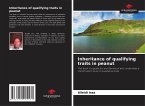In Brazil, the cowpea (Vigna unguiculata (L.) Walp.) has a series of common names that vary according to the region. In the North and Northeast, where it is most widely grown, it is known as macassar bean, string bean and beach bean. It is an important source of protein in the diet of Brazilians in the North and Northeast. There is a preference in the domestic and foreign markets for large, white, light brown and evergreen beans, with a rough integument and a small hilum and hilum ring. The occurrence of viruses causes yield losses of up to 80% in the most susceptible cultivars. The main viruses infecting the cowpea crop in Brazil are: Cowpea severe mosaic virus (CPSMV); Cowpea aphid-born mosaic virus (CABMV); Cucumber mosaic virus (CMV) and Cowpea golden mosaic virus (CPGMV). The aim of this work was to select cowpea progenies with a rough white seed coat, with grain characteristics that are well accepted on the market and expressing resistance to the CPSMV (serotype I) and CABMV viruses.
Bitte wählen Sie Ihr Anliegen aus.
Rechnungen
Retourenschein anfordern
Bestellstatus
Storno








